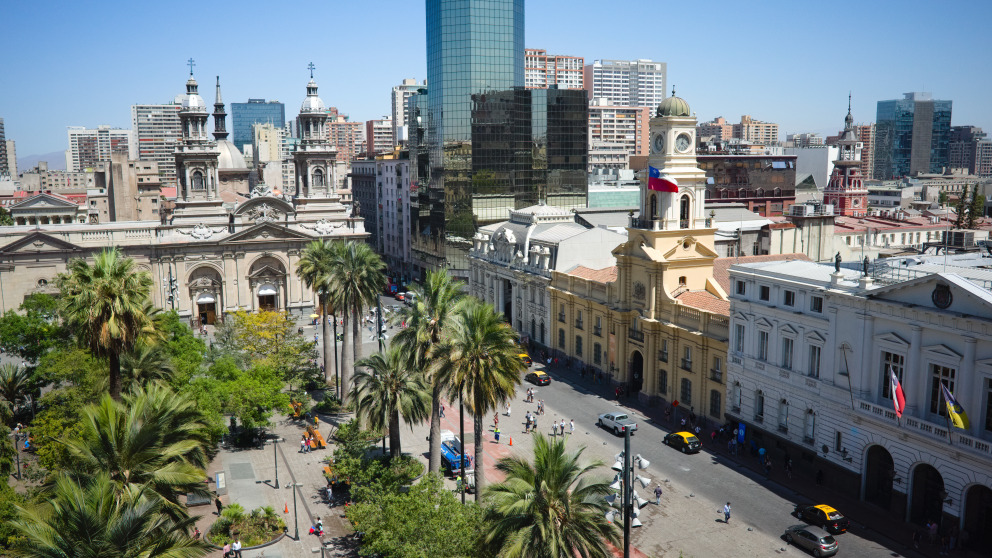Heat-Ozone Extremes Affect Mortality
10.07.2023
Cities in the Global South are particularly vulnerable to the impacts of global warming. Rising temperatures are worsening the effects of ozone pollution, for example. Like many other cities in the Global South, Santiago de Chile is highly segregated along socio-economic lines. RIFS scientist Tabish Ansari and a team of researchers have examined and compared the effects of heatwaves and ozone episodes in different areas of the city.

Santiago de Chile is a city with distinct zones of affluence and deprivation. For their study published in the journal Scientific Reports, a team of researchers and RIFS scientist Tabish Ansari combined existing datasets of social indicators and climate-sensitive health risks with weather and air quality observations in order to study the response of different socio-economic strata to so-called “compound events” (concurrent heat waves and ozone episodes).
Climatic setting
Santiago de Chile is a major mid-latitude Andean city of 7.7 million inhabitants. Located in the country’s central valley, it lies between 500 and 650 m above sea level. Heat waves and extreme temperatures have increased significantly in the region in recent years due to climate change. In this context, heat waves are understood as periods of consecutive days with warmer than usual conditions.
Heat waves and ozone episodes frequently coincide as they share meteorological drivers. Heatwaves exacerbate ground level ozone pollution, and excessive heat increases the risk of heatstroke or dehydration, which disproportionately affects vulnerable populations around the world, as they frequently lack access to adequate cooling systems.
Due to poor air quality, too many people breath unhealthy air in Santiago on too many days of the year, with most of the population living in areas affected by unhealthy ozone levels in the summer and particulate pollution in the winter. Both the 24-hour mean concentration of particulate matter and the daily maximum concentration of ozone frequently exceed the levels recommended by the World Health Organization (WHO). As a consequence, millions of Chileans are exposed to more than 40 unhealthy ozone days annually.
Mortality is twice as high in poorer municipalities
Affluence and deprivation drive inequalities in mortality rates across Santiago’s more than 30 municipalities. In deprived municipalities, the annual mortality rate for adults aged 65 and older is twice as high as affluent areas.
However, this disparity in mortality rates decreases in the summer months for adults aged 65 and older. While spatial variations in temperature slightly favour residents in the city's more affluent north-eastern municipalities, this is not the case when it comes to air pollution. The ground-level ozone pollution burden is considerably higher for wealthy inhabitants of north-eastern municipalities in Santiago. Ansari's team found that due to spatial variations in temperature and surface ozone concentrations, heat-ozone extremes affect urban residents aged 65 and older roughly the same, regardless of their socioeconomic status.
However, the team predicts that the currently narrow gap in summer mortality rates between the rich and poor will widen in the future. If heat waves become more frequent and intense in the future, lower-income adults are more likely to die earlier than more affluent residents of the city, in particular due to poorer diets and related pre-existing medical conditions that reduce heat endurance.
Recommendations
The team's findings underline the need for ambitious adaptation strategies to minimize the public health impacts of compound heat-ozone extremes. For example, the researchers recommend the development of a heat/health warning system. According to recommendations issued by WHO and the World Meteorological Organization, warnings should be based on health effects, not just air temperature. In Chile, authorities already issue public warnings in the event of heat waves, but these do not take into account additional parameters such as the link between extreme heat and mortality. Overall, an improved understanding of the impacts of compound heat-ozone extremes on human health would contribute to building more resilient and sustainable communities in the Global South, the authors argue.
Publication:
Feron, S., Cordero, R.R., Damiani, A. et al. Compound climate-pollution extremes in Santiago de Chile. Sci Rep 13, 6726 (2023). https://doi.org/10.1038/s41598-023-33890-w

